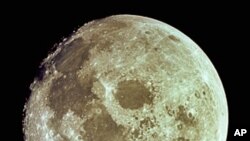A new theory by planetary scientists says the Earth may once have been orbited by two moons, which formed early in the history of the solar system and collided slowly into one another to form a single Moon.
Collision course
Scientists believe the Moon was formed when a Mars-sized object crashed into Earth some 4.5 billion years ago and the debris accreted, or came together to form the Moon.
But to Erik Asphaug a planetary scientist at the University of California Santa Cruz, that does not address what astronomers call the lunar dichotomy between the visible side of the moon, marked by craters and a thin crust, and the far side of the moon, known to contain a thicker crust and mountain ranges topping 3,000 meters.
Using a computer model, Asphaug and Martin Jutzi of the University of Bern in Switzerland devised a scenario of what might have caused the geographic dichotomy between the visible and far sides of the Moon. They believe it was caused by a slow-moving collision, less than 2.5 kilometers per second, by a nearby smaller moon.
“It turns out when the impact that is striking the moon comes from right next door to the moon, it doesn’t have a lot of velocity - it’s a pretty slow collision," said Asphaug. "And by the time it hits the moon, it doesn’t have enough energy to excavate a big crater. All it has the velocity to do is squash itself flat as a big pancake. And that was a real surprising finding of the result, and when we saw that in the renderings of the computer simulations, we knew we were on to something pretty interesting.”
The theory
How did this collision between the two moons occur? Scientists believe the smaller sister moon, made of the same rocky debris as the larger moon became stuck in the gravity between Earth and the bigger moon billions of years ago, drawing the smaller lunar object into an impact with the moon.
Paul Spudis, a planetary scientist at the Lunar and Planetary Institute in Houston, Texas is withholding judgment on the theory.
“It’s an intriguing idea and like all new ideas, we need to evaluate it carefully," said Spudis. "But I think there are some issues with it. And I’m not against it and I’m not for it. I prefer just to remain skeptical at the moment.”
Scientists believe the lunar dichotomy could be explained if they could compare mineral samples from the near and far sides of the moon.
The US space agency NASA will next month launch the GRAIL or Gravity Recovery and Interior Laboratory mission that should help increase astronomers’ understanding of the moon. GRAIL’s twin spacecraft will fly in tandem orbits around the moon, measuring its gravity fields.
It is hoped the mission, which will analyze the moon’s crust through to its core, will help scientists better understand the formation of rocky planets in our solar system.
An article on the possibility of two moons in Earth’s orbit is published in the journal Nature.
Scientists Think Earth Once Had 2 Moons
